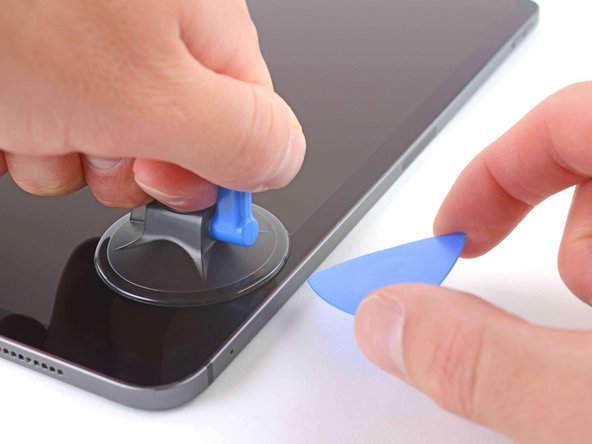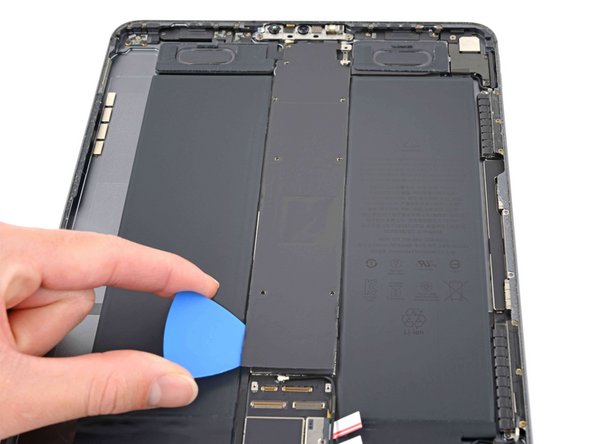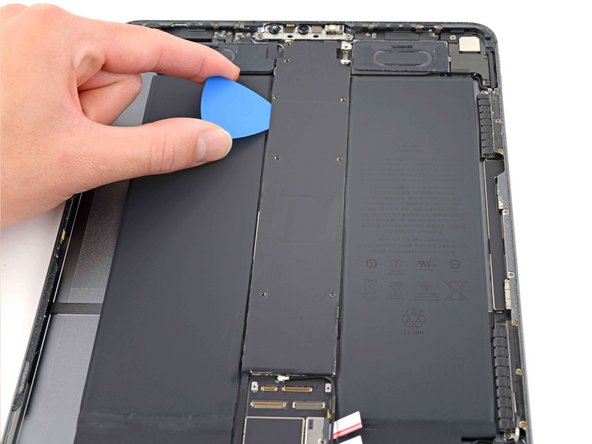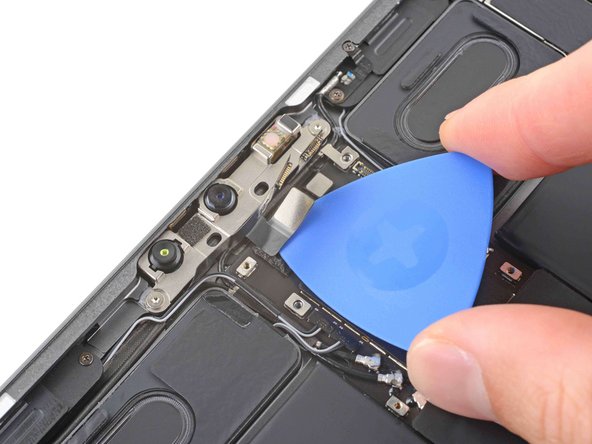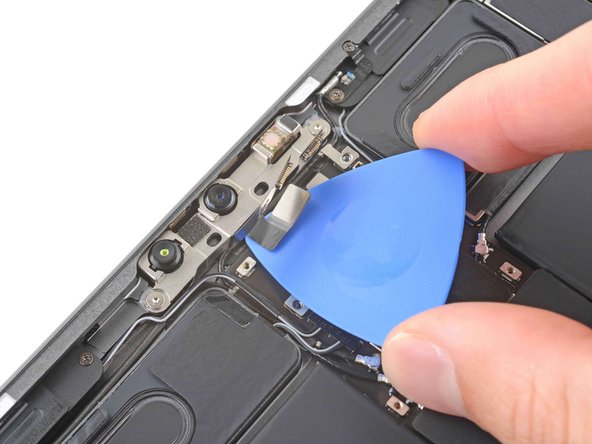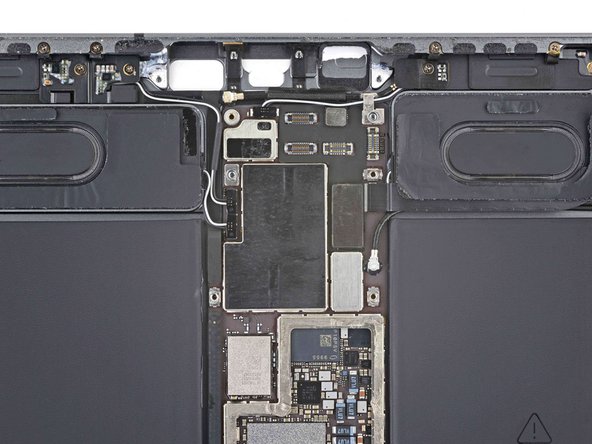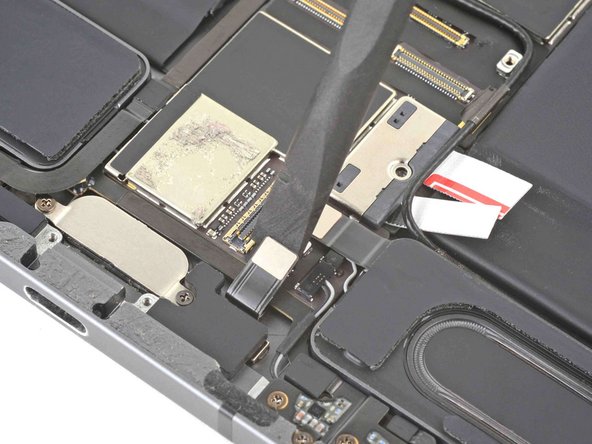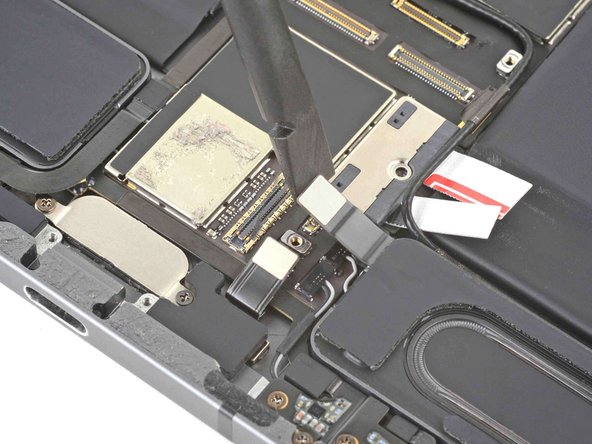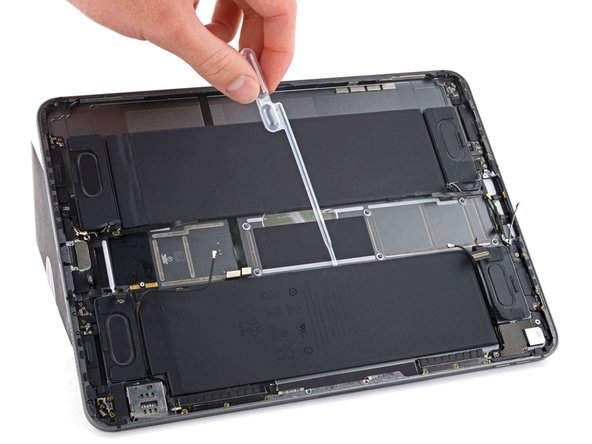Esta versão pode conter edições incorretas. Mude para o último instantâneo verificado.
O que você precisa
-
Este passo não foi traduzido. Ajude a traduzi-lo
-
Camera module, ambient light sensors, proximity senor, and front microphone
-
Display cables
-
Screen magnets
-
LCD edges
-
-
Este passo não foi traduzido. Ajude a traduzi-lo
-
Apply a heated iOpener to the right edge of the screen for two minutes.
-
-
Este passo não foi traduzido. Ajude a traduzi-lo
-
Pull the blue handle backwards to unlock the Anti-Clamp's arms.
-
Place an object under your iPad so it rests level between the suction cups.
-
Position the suction cups near the middle of the right edge—one on the top, and one on the bottom.
-
Hold the bottom of the Anti-Clamp steady and firmly press down on the top cup to apply suction.
-
-
Este passo não foi traduzido. Ajude a traduzi-lo
-
Pull the blue handle forward to lock the arms.
-
Turn the handle clockwise 360 degrees or until the cups start to stretch.
-
Make sure the suction cups remain aligned with each other. If they begin to slip out of alignment, loosen the suction cups slightly and realign the arms.
-
-
Este passo não foi traduzido. Ajude a traduzi-lo
-
Wait one minute to give the adhesive a chance to release and present an opening gap.
-
If your screen isn't getting hot enough, you can use a hair dryer to heat along the right edge of the iPad.
-
Insert an opening pick under the screen when the Anti-Clamp creates a large enough gap.
-
Skip the next step.
-
-
Este passo não foi traduzido. Ajude a traduzi-lo
-
Apply a suction handle to the right edge of the screen, about 5 cm from the bottom edge.
-
Pull up on the suction handle with firm, constant pressure to create a gap large enough to insert an opening pick.
-
Insert the tip of an opening pick into the gap.
-
-
Este passo não foi traduzido. Ajude a traduzi-lo
-
Insert a new opening pick in the gap you just created.
-
Slide the pick along the right edge to separate the adhesive.
-
Leave the pick in the top right corner to prevent the adhesive from re-sealing.
-
-
Este passo não foi traduzido. Ajude a traduzi-lo
-
Apply a heated iOpener to the top edge of the screen for two minutes.
-
-
Este passo não foi traduzido. Ajude a traduzi-lo
-
Don't insert an opening pick more than 2 mm near the top left and right edges or you'll damage the ambient light sensors.
-
Don't insert an opening pick more than 1 mm near the middle of the top edge or you'll damage the camera module, proximity sensor, and front microphone.
-
-
Este passo não foi traduzido. Ajude a traduzi-lo
-
Insert a new opening pick in the gap you just created.
-
Slide the pick along the top right edge, stopping when you reach the right ambient light sensor.
-
Leave the pick to the right of the sensor to prevent the adhesive from re-sealing.
-
-
Este passo não foi traduzido. Ajude a traduzi-lo
-
Insert a new opening pick to the right of the ambient light sensor.
-
Slide the pick along the middle section of the top, stopping when you reach the left ambient light sensor.
-
Leave the pick in to prevent the adhesive from re-sealing.
-
-
Este passo não foi traduzido. Ajude a traduzi-lo
-
Insert a new opening pick to the left of the ambient light sensor.
-
Slide the pick along the top left edge, stopping when you reach the left ambient light sensor.
-
Once the top edge adhesive has been separated, you can remove the two picks near the ambient light sensors.
-
-
Este passo não foi traduzido. Ajude a traduzi-lo
-
Apply a heated iOpener to the bottom edge of the screen for two minutes.
-
-
Este passo não foi traduzido. Ajude a traduzi-lo
-
Insert a new opening pick in the bottom right corner below the existing pick.
-
Slide the pick around the bottom right corner to separate the adhesive.
-
-
Este passo não foi traduzido. Ajude a traduzi-lo
-
Slide the opening pick along the bottom edge, stopping at the USB-C port.
-
Leave the pick in to prevent the bottom edge adhesive from re-sealing.
-
-
Este passo não foi traduzido. Ajude a traduzi-lo
-
Insert a new opening pick to the left of the USB-C port.
-
Separate the remaining bottom edge adhesive.
-
Leave the pick in the bottom left corner to prevent the bottom edge adhesive from re-sealing.
-
-
Este passo não foi traduzido. Ajude a traduzi-lo
-
Apply a heated iOpener to the left edge of the screen for two minutes.
-
-
Este passo não foi traduzido. Ajude a traduzi-lo
-
The display cables are located within small indents of the frame and require an opening pick to be inserted at a 45° angle.
-
There are flat sections of the frame which require an opening pick to be inserted horizontally.
-
-
Este passo não foi traduzido. Ajude a traduzi-lo
-
Insert an opening pick at a 45˚ angle just above the bottom left corner.
-
Carefully slide the pick along the left edge, stopping when you reach the flat section of the frame.
-
-
Este passo não foi traduzido. Ajude a traduzi-lo
-
Lower the opening pick so it is horizontal to the screen.
-
Continue separating the left edge adhesive until you reach the next indented section of the frame.
-
-
Este passo não foi traduzido. Ajude a traduzi-lo
-
Separate the remaining adhesive, making sure to follow the instructions exactly as written.
-
Slide the pick at a 45˚ downward angle and don't insert the pick more than 5 mm.
-
Slide the pick horizontally and don't insert the pick more than 5 mm.
-
-
Este passo não foi traduzido. Ajude a traduzi-lo
-
Grab two opposing corners of the screen and gently separate the rest of the adhesive.
-
Shift the screen towards the bottom right corner of the frame until the ambient light sensor ribbon cable near the top edge is uncovered.
-
-
Este passo não foi traduzido. Ajude a traduzi-lo
-
Use a Phillips screwdriver to remove the two screws securing the ambient light sensor cable bracket to the logic board:
-
One 1.3 mm screw
-
One 2.0 mm screw
-
-
Este passo não foi traduzido. Ajude a traduzi-lo
-
Use tweezers or your fingers to remove the bracket.
-
-
Este passo não foi traduzido. Ajude a traduzi-lo
-
Use the flat end of a spudger to disconnect the ambient light sensor cable by lifting straight up on the press connector.
-
-
Este passo não foi traduzido. Ajude a traduzi-lo
-
Grip the right edge of the screen and fold it open like a book.
-
Lay the screen down over the left edge of the iPad.
-
-
-
Este passo não foi traduzido. Ajude a traduzi-lo
-
Use the pointed end of a spudger to pry up and disconnect the top two display cables.
-
-
Este passo não foi traduzido. Ajude a traduzi-lo
-
Grip the right edge of the screen and lift it away.
-
-
Este passo não foi traduzido. Ajude a traduzi-lo
-
Use a Phillips screwdriver to remove the three 1.2 mm screws securing the bottom cable shield to the logic board.
-
-
Este passo não foi traduzido. Ajude a traduzi-lo
-
Use tweezers or your fingers to remove the bottom cable shield.
-
-
Este passo não foi traduzido. Ajude a traduzi-lo
-
Use a Phillips screwdriver to remove the 1.8 mm screw securing the battery connector to the logic board.
-
-
Este passo não foi traduzido. Ajude a traduzi-lo
-
Use the flat end of a spudger to disconnect the USB-C port cable.
-
-
Este passo não foi traduzido. Ajude a traduzi-lo
-
Slide an opening pick between the cable and the logic board to separate the adhesive.
-
-
Este passo não foi traduzido. Ajude a traduzi-lo
-
Use a Phillips screwdriver to remove the two 1.9 mm screws securing the USB-C port to the frame.
-
-
Este passo não foi traduzido. Ajude a traduzi-lo
-
Use tweezers to remove the two grounding contacts from each side of the USB-C port.
-
-
Este passo não foi traduzido. Ajude a traduzi-lo
-
Use a Phillips PH00 screwdriver to remove the eight screws securing the shield to the logic board:
-
Five 2 mm screws
-
Three 1.2 mm screws
-
-
Este passo não foi traduzido. Ajude a traduzi-lo
-
Apply a heated iOpener to the top of the logic board for two minutes.
-
-
Este passo não foi traduzido. Ajude a traduzi-lo
-
Insert an opening pick between the shield and the shielding gasket on the bottom edge of the logic board.
-
Slide the pick along the bottom edge to separate the adhesive.
-
-
Este passo não foi traduzido. Ajude a traduzi-lo
-
Repeat the previous step for the right edge of the logic board shield.
-
-
Este passo não foi traduzido. Ajude a traduzi-lo
-
Repeat the previous step for the left edge of the logic board shield.
-
-
Este passo não foi traduzido. Ajude a traduzi-lo
-
Grip the logic board shield at the top and lift it up.
-
-
Este passo não foi traduzido. Ajude a traduzi-lo
-
Use the pointed end of a spudger to disconnect the IR dot projector cable.
-
-
Este passo não foi traduzido. Ajude a traduzi-lo
-
Use the pointed end of a spudger to disconnect the front-facing camera and Face ID camera.
-
-
Este passo não foi traduzido. Ajude a traduzi-lo
-
Slide an opening pick between the IR camera cable and the logic board to separate it.
-
-
Este passo não foi traduzido. Ajude a traduzi-lo
-
Use a Torx T3 screwdriver to remove the two 2.1 mm screws securing the front camera assembly to the frame.
-
-
Este passo não foi traduzido. Ajude a traduzi-lo
-
Use the pointed end of a spudger to pry up and loosen the front camera assembly.
-
-
Este passo não foi traduzido. Ajude a traduzi-lo
-
Use tweezers or your fingers to remove the front camera assembly.
-
-
Este passo não foi traduzido. Ajude a traduzi-lo
-
Use the flat end of a spudger to disconnect the rear camera interconnect cable.
-
Fold the interconnect cable over so the top right speaker cable is accessible.
-
-
Este passo não foi traduzido. Ajude a traduzi-lo
-
Use the flat end of a spudger to disconnect the top microphone cable.
-
-
Este passo não foi traduzido. Ajude a traduzi-lo
-
Use the pointed end of a spudger to disconnect the two cables for the top right speaker.
-
-
Este passo não foi traduzido. Ajude a traduzi-lo
-
Repeat the previous step for the two top left speaker cables.
-
-
Este passo não foi traduzido. Ajude a traduzi-lo
-
Use the pointed end of a spudger to disconnect the top interconnect board.
-
-
Este passo não foi traduzido. Ajude a traduzi-lo
-
Use the pointed end of a spudger to disconnect the top Wi-Fi antenna cable.
-
-
Este passo não foi traduzido. Ajude a traduzi-lo
-
Use the flat end of a spudger to disconnect the Smart Connector and SIM card reader cables.
-
-
Este passo não foi traduzido. Ajude a traduzi-lo
-
Follow the procedure in step 57 to disconnect the bottom right speaker.
-
-
Este passo não foi traduzido. Ajude a traduzi-lo
-
Use tweezers to peel back the tape securing the bottom left speaker cable bracket to the logic board.
-
Slide the bracket out horizontally.
-
-
Este passo não foi traduzido. Ajude a traduzi-lo
-
Use the pointed end of a spudger to disconnect the bottom left LTE wireless cable.
-
-
Este passo não foi traduzido. Ajude a traduzi-lo
-
Follow the procedure in step 57 to disconnect the bottom right speaker.
-
-
Este passo não foi traduzido. Ajude a traduzi-lo
-
Follow the procedure in 59 to disconnect the bottom interconnect cable.
-
-
Este passo não foi traduzido. Ajude a traduzi-lo
-
Use the pointed end of a spudger to disconnect the bottom Wi-Fi antenna cable.
-
Peel the cable away from the logic board and reposition it to the right.
-
-
Este passo não foi traduzido. Ajude a traduzi-lo
-
Use the pointed end of a spudger to disconnect the left microphone and Apple Pencil charger cables.
-
-
Este passo não foi traduzido. Ajude a traduzi-lo
-
Prop the left side of the iPad up against an object so the isopropyl alcohol can flow under the logic board.
-
Apply a few drops of isopropyl alcohol along the left edge of the logic board.
-
Let the alcohol soak for one minute to soften the adhesive under the logic board.
-
-
Este passo não foi traduzido. Ajude a traduzi-lo
-
Rotate your iPad 180˚ and lay it down with the right side elevated.
-
Repeat the previous step for the right edge of the logic board.
-
-
Este passo não foi traduzido. Ajude a traduzi-lo
-
Insert the flat end of a spudger between the logic board and the bottom right speaker.
-
Slowly pry up the bottom of the logic board.
-
Replace the playing card strips with an opening pick to block the battery.
-
-
Este passo não foi traduzido. Ajude a traduzi-lo
-
Slide an opening pick under the left edge of the logic board to loosen it.
-
Pry against the frame underneath the logic board to separate the adhesive.
-
-
Este passo não foi traduzido. Ajude a traduzi-lo
-
Insert an opening pick under the right edge of the logic board above the left microphone and Apple Pencil charger cables.
-
Repeat the previous step for the right side of the logic board.
-
-
Este passo não foi traduzido. Ajude a traduzi-lo
-
Grip the top and bottom edges of the logic board.
-
Remove the logic board.
-
-
Este passo não foi traduzido. Ajude a traduzi-lo
-
Six on the inside edge of the left battery cell
-
Five on the inside edge of the right battery cell
-
The remainder of the adhesive is located under the battery boards.
-
Use your fingernails or tweezers to peel each pull tab away from the edge of the battery.
-
-
Este passo não foi traduzido. Ajude a traduzi-lo
-
Pull the strip out slowly and steadily at a low angle. Give it plenty of time to stretch and un-stick from under the battery cells.
-
If the adhesive strip breaks off, try to retrieve it using your fingers or tweezers, and continue pulling.
-
-
Este passo não foi traduzido. Ajude a traduzi-lo
-
Prop the left side of the iPad up against an object so the isopropyl alcohol can flow under the right battery cell.
-
Apply high-strength (>90%) isopropyl alcohol along the inside edge of the right battery cell.
-
Let the alcohol soak for two minutes to soften the adhesive under the battery cell.
-
-
Este passo não foi traduzido. Ajude a traduzi-lo
-
Rotate the iPad 180 degrees so the inner edge of the left battery is facing up.
-
Repeat the previous step for the left battery cell.
-
-
Este passo não foi traduzido. Ajude a traduzi-lo
-
Lay the iPad down flat on your work surface.
-
Starting at the top, insert a plastic card under the right battery cell.
-
Slide the plastic card toward the bottom of the iPad to separate the adhesive.
-
Stop sliding when you reach the Apple Pencil charger cable.
-
-
Este passo não foi traduzido. Ajude a traduzi-lo
-
Repeat the previous step for the left battery.
-
Stop sliding when you reach the left microphone cable.
-
-
Este passo não foi traduzido. Ajude a traduzi-lo
-
Lift up the left battery cell.
-
Insert an opening pick under the left battery board and separate the remaining adhesive securing it to the frame.
-
-
Este passo não foi traduzido. Ajude a traduzi-lo
-
Repeat the previous step for the right battery cell.
-
-
Este passo não foi traduzido. Ajude a traduzi-lo
-
Lift both battery cells out of the iPad at the same time.
-
Cancelar: não concluí este guia.
4 outras pessoas executaram este guia.
4 comentários
Extremely upset with this guide! It didn’t have me disconnect the battery first. When taking off the first display cable, the logic board sparked and shorted out, frying the whole thing! Not even my iPad which makes it so much worse.
I completed this and the screen powers on (goes dark blue) but isn’t showing anything. The iPad makes sounds. Anyone have any tips?














